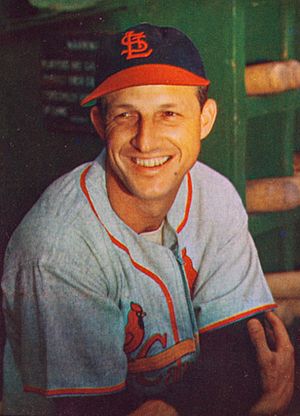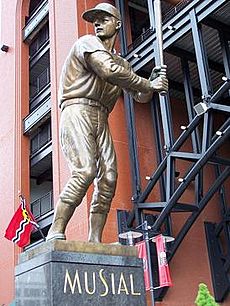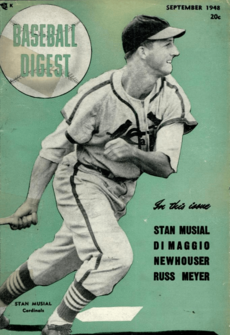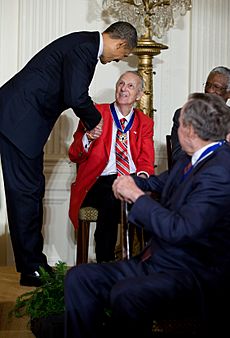Stan Musial facts for kids
Quick facts for kids Stan Musial |
|||
|---|---|---|---|

Musial in 1953
|
|||
| Outfielder / First baseman | |||
| Born: November 21, 1920 Donora, Pennsylvania, U.S. |
|||
| Died: January 19, 2013 (aged 92) Ladue, Missouri, U.S. |
|||
|
|||
| debut | |||
| September 17, 1941, for the St. Louis Cardinals | |||
| Last appearance | |||
| September 29, 1963, for the St. Louis Cardinals | |||
| MLB statistics | |||
| Batting average | .331 | ||
| Hits | 3,630 | ||
| Home runs | 475 | ||
| Runs batted in | 1,951 | ||
| Teams | |||
|
|||
| Career highlights and awards | |||
|
|||
| Induction | 1969 | ||
| Vote | 93.2% (first ballot) | ||
Stanley Frank Musial (born Stanislaw Franciszek Musial; November 21, 1920 – January 19, 2013) was an American baseball player. He was nicknamed "Stan the Man" because he was such a great player. Stan spent 22 seasons playing in Major League Baseball (MLB) for the St. Louis Cardinals. He played from 1941 to 1944 and again from 1946 to 1963.
Stan Musial is known as one of the best and most consistent hitters in baseball history. He was voted into the Baseball Hall of Fame in 1969 on his first try. During his career, he had a batting average of .331. He set many records in the National League (NL), including career hits (3,630) and runs batted in (1,951). He also had 475 home runs.
Musial won the NL batting title seven times. He was named the NL's Most Valuable Player (MVP) three times. He also helped his team win three World Series championships. Stan shares the MLB record for playing in the most All-Star Games (24).
Stan was born in Donora, Pennsylvania, where he played baseball all the time. He signed with the St. Louis Cardinals as a pitcher in 1938. But he soon became an outfielder and made his major league debut in 1941. He was famous for his special batting stance. In his first full season, 1942, the Cardinals won the World Series. The next year, he won his first MVP award. He was an All-Star every season he played after that.
Musial won his second World Series in 1944. He then served in the Navy during 1945. After the war, he returned to baseball in 1946. That year, he won his second MVP award and his third World Series title. His third MVP award came in 1948. He almost won the Triple Crown that year. Stan retired in 1963. When he retired, he held or shared many major league records.
After playing, Musial ran businesses, including a restaurant. He also served as the Cardinals' general manager in 1967. The team won the World Series that year. In 1999, Musial was chosen for the Major League Baseball All-Century Team. In 2011, President Barack Obama gave him the Presidential Medal of Freedom. This is the highest award a civilian can get from the U.S. government.
Contents
- Stan Musial's Early Life and Baseball Dreams
- Stan's Journey to the Major Leagues
- Life After Baseball and Family
- Awards and Special Recognition
- Stan Musial's Passing
- Stan Musial's Lasting Legacy
- Images for kids
- See also
Stan Musial's Early Life and Baseball Dreams
Stan Musial was born in Donora, Pennsylvania. He was one of six children. His mother was from Carpatho-Rusyn, and his father was a Polish immigrant. His father called him "Stashu," a Polish nickname. Young Stan loved playing baseball with his brother and friends. He looked up to baseball player Lefty Grove. Stan also learned a lot from his neighbor, Joe Barbao, who used to be a minor league pitcher. When he started school, his name was officially changed to Stanley Frank Musial.
When he was 15, Stan joined a semi-professional team called the Donora Zincs. Joe Barbao was their manager. In his first game, Stan pitched six innings and struck out 13 grown-up batters. He also played on his high school baseball team. One of his teammates was Buddy Griffey, whose son and grandson (Ken Griffey Sr. and Ken Griffey Jr.) also became famous baseball players. People called Stan "The Donora Greyhound" because he was such a good player.
Stan was also good at basketball. He was even offered a scholarship to play basketball at the University of Pittsburgh. But the St. Louis Cardinals had noticed Stan as a pitcher. In 1937, they offered him a professional contract. Stan's father didn't want him to play baseball professionally at first. But he finally agreed after Stan and his mother convinced him. Stan also thanked his school librarian, Helen Kloz, for telling him to follow his dream of playing baseball. He joined the Cardinals' team in West Virginia, the Williamson Red Birds, in 1938.
Stan's Journey to the Major Leagues
Playing in the Minor Leagues (1938–1941)
Stan's first year with Williamson in 1938 was a learning time. He learned more about baseball strategy. He also had to get used to living on his own with a small salary. He finished high school and returned to Williamson in 1939. That year, his pitching and hitting got much better.
In 1940, Stan played for the Daytona Beach Islanders. There, he became good friends with his manager, Dickie Kerr. Kerr helped Stan improve his pitching. He also saw how good Stan was at hitting. So, he let Stan play in the outfield when he wasn't pitching. In May 1940, Stan married Lillian "Lil" Labash.
Later that year, Stan hurt his shoulder while playing in the outfield. He thought about quitting baseball because he wasn't earning much money. But Dickie Kerr convinced him to stay. Kerr even let Stan and Lil live with him to help them out. Stan never forgot Kerr's kindness.
Stan was sent to the Columbus Red Birds in 1941. But his arm was still weak from his injury. So, he was moved to the Springfield Cardinals as a full-time outfielder. He hit very well there, with a .379 batting average. Then he was promoted to the Rochester Red Wings.
Stan was known for his special batting stance. He would crouch down, almost facing the pitcher with his back. Pitcher Ted Lyons joked that he looked like "a kid peeking around the corner." This stance made him look like a "coiled spring," ready to hit. Stan played well in Rochester and was called up to the St. Louis Cardinals for the last two weeks of the 1941 season.
Becoming a Major League Star (1941–1944)

Stan Musial played his first major league game on September 17, 1941. The Cardinals were trying to win their league. In his first 12 games, Stan got 20 hits and had a .426 batting average. Even with his help, the Cardinals finished second that year.
In 1942, Cardinals manager Billy Southworth played Stan in left field. Stan was hitting .315 by June. The Cardinals were battling the Dodgers for first place. On September 13, the Cardinals took the lead. They won the league title on September 27. Stan finished the season with a .315 batting average and 72 runs batted in (RBI). He became famous when a sports editor called him his choice for Rookie of the Year.
The Cardinals played the New York Yankees in the 1942 World Series. Stan got his first hit of the Series in Game 2. It was an RBI single that helped the Cardinals win. The Cardinals went on to beat the Yankees in five games. Stan batted .222 in the Series.
In 1943, Stan made the National League All-Star team for the first time. He hit a double in the All-Star Game. He finished the season leading the major leagues with a .357 batting average. He also led the NL in hits (220), doubles (48), and triples (20). This amazing performance earned him his first NL Most Valuable Player Award. The Cardinals won the NL title again. They faced the Yankees in the 1943 World Series but lost.
In 1944, Stan stayed with the Cardinals for the whole season. He had a .347 batting average and 197 hits. The Cardinals won the NL title for the third year in a row. They played against the St. Louis Browns in the 1944 World Series. Stan hit a two-run home run in Game 4, helping the Cardinals win. The Cardinals beat the Browns in six games. Stan batted .304 in the Series.
Stan Musial joined the United States Navy on January 23, 1945, during World War II. He was sent to Hawaii in June 1945. There, he played baseball every afternoon in the naval base's league. He was honorably discharged from the Navy in March 1946. In 2007, Stan received the Navy Memorial's Lone Sailor Award. This award honors Navy veterans who have done great things in civilian life.
Back to the Major Leagues (1946–1963)
The Rise of "Stan the Man" (1946–1949)
Stan rejoined the Cardinals in 1946. He quickly started hitting well again. He also became good friends with his new teammate, Red Schoendienst. During this season, Stan was offered a lot of money to join another league, but he chose to stay with the Cardinals.
It was in 1946 that Stan got his famous nickname, Stan the Man. During a game against the Dodgers, a sportswriter heard Dodger fans chanting, "Here comes the man!" The nickname stuck, and from then on, he was known as Stan "The Man."
The Cardinals finished the 1946 season tied with the Dodgers. They played a three-game playoff, and the Cardinals won. Then, they faced the Boston Red Sox in the 1946 World Series. The Cardinals won the Series in seven games. Stan batted .365 for the season and won his second NL MVP Award.
In 1947, Stan had some health problems but still finished the year with a .312 batting average. In 1948, he was fully recovered. On April 25, he got his 1,000th career hit. He also decided not to appear in cigarette ads anymore. By June 24, his batting average was an amazing .408. He hit a home run in the All-Star Game.
Stan finished the 1948 season leading the major leagues in batting average (.376) and hits (230). He won his third NL MVP award. He almost won the Major League Baseball Triple Crown that year.
In 1949, Stan opened his first business, a restaurant called "Stan Musial & Biggie's." He tried to hit more home runs that season, but it didn't work out. He soon went back to his usual hitting style. He was selected for his sixth All-Star team and played in every game.
Stan Musial was also known for treating everyone with respect. As baseball started to include more players of different races in the late 1940s, Stan and his teammate Red Schoendienst were praised for being welcoming to new players.
Continued Success (1950–1954)
Stan started the 1950s strong, with a .350 batting average. He had the longest hitting streak of his career that year, hitting safely in 30 games in a row. In 1951, he led the National League with a .355 batting average. He was named The Sporting News Major League Player of the Year.
In 1952, famous baseball player Ty Cobb said that Stan Musial was "a better player than Joe DiMaggio was in his prime." Stan, being modest, said he wasn't as good as DiMaggio. Stan also made his only major league pitching appearance in 1952 as a joke. He pitched to another great hitter, but the play ended in an error. Stan was embarrassed and never pitched again.
In 1953, the Cardinals team was for sale. Stan and his friend Red Schoendienst suggested that their friend Gussie Busch buy the team. Busch bought the Cardinals, which kept Stan in St. Louis. Stan made his 10th NL All-Star team that year. He also had his 12th season in a row with a batting average over .300.
On May 2, 1954, Stan made history. In a doubleheader, he hit three home runs in the first game and two more in the second. This made him the first major league player to hit five home runs in a doubleheader!
Later Career and Milestones (1955–1959)
In 1955, Stan made his 12th NL All-Star appearance. He hit a home run in the 12th inning to win the game for the NL. In 1956, Stan broke Mel Ott's NL record for extra-base hits. The Cardinals' owner, Gussie Busch, made it clear that Stan was too important to trade.
On June 11, 1957, Stan tied the NL record for playing in 822 consecutive games. This streak started in 1951. He was chosen for the All-Star Game again. But on August 23, he hurt his shoulder, ending his consecutive games streak at 895. He was named Sports Illustrated's "Sportsman of the Year" for 1957.
Stan signed one of the first $100,000 contracts in NL history in 1958. He quickly showed he was worth it. On May 13, he got his 3,000th career hit. He was the eighth major league player to reach 3,000 hits. He was also the first to do it with an extra-base hit. Fans greeted him like a hero when he returned to St. Louis.
In 1959, Stan tried a new way to get ready for the season. He reported late to spring training to save energy. He also gained some weight. He started the season slowly. But on May 7, he hit a game-winning home run. This made him the first major league player with both 400 home runs and 3,000 hits. He made his 16th All-Star appearance that year.
Final Seasons and Retirement (1960–1963)
Stan accepted a pay cut in 1960. He wanted to prove that his slow 1959 season was just because he wasn't in shape. He worked with a physical education director to get stronger. Even though newspapers thought he might retire, he played again in 1961. His .288 batting average showed he made the right choice.
In 1962, Stan had a great season. He batted .330, which was third best in the league. He also hit 19 home runs and had 82 RBI. He set new NL career records for hits and RBI. On July 8, at 41 years old, Stan became the oldest player to hit three home runs in one game.
 |
|
| Stan Musial's number 6 was retired by the St. Louis Cardinals in 1963. |
The Cardinals started 1963 well. Stan set a new major league record for career extra-base hits on May 8. On July 26, he told the general manager he would retire at the end of the season. He announced it publicly on August 12.
Stan's last game was on September 29, 1963. Before the game, there was a long retirement ceremony. The Cardinals announced that his uniform number "6" would be retired. During the game, Stan got two hits, just like in his very first game. He hit a single in the fourth inning. Then, in the sixth, he hit another single that scored a teammate. The manager sent in a pinch-runner for Stan, ending his amazing career.
When he retired, Stan Musial held or shared many major league, NL, and All-Star Game records. He had 3,630 hits, which was the most in NL history. He was never ejected from a game in his 22-year career. Sportscaster Bob Costas said that Stan was a "perfect warrior" and a "complete decency as a human being."
Life After Baseball and Family
After retiring, Stan Musial became a vice president for the St. Louis Cardinals. He also worked as President Lyndon B. Johnson's physical fitness adviser. In 1967, he became the Cardinals' general manager. He helped the team win the World Series that year. He was fair to players when negotiating contracts. He even created a babysitting service at the stadium for players' wives.
Stan's business partner, Biggie Garagnani, passed away in 1967. Stan then spent more time on his restaurant and other businesses. He realized that the detailed office job wasn't for him. So, he stepped down as general manager.
Stan was also known for playing the harmonica. He often played "Take Me Out to the Ball Game" at public events. He even recorded 18 songs in 1994.
Even though Stan left Donora after high school, he stayed connected to his hometown. He gave free meals at his St. Louis restaurant to anyone from Donora.
Stan met Lillian Susan Labash when they were both 15. They got married on May 25, 1940. They had four children: Richard, Gerry, Janet, and Jeanie. Lillian passed away in 2012, after almost 72 years of marriage.
During his playing days, Stan believed in fairness for everyone. He supported Jackie Robinson's right to play baseball. He also refused to promote tobacco products after learning they were harmful.
Awards and Special Recognition
On August 4, 1968, a statue of Stan Musial was put up outside Busch Memorial Stadium in St. Louis. The statue was later moved to the new Busch Stadium in 2006. It became a popular meeting spot for Cardinals fans. The statue has a quote calling him "baseball's perfect warrior" and "perfect knight."
Stan was elected to the Baseball Hall of Fame in 1969. He was chosen on 93.2% of the ballots. In 1973, he was the first person inducted into the National Polish-American Hall of Fame. In 1989, he was added to the St. Louis Walk of Fame. His hometown of Donora named a baseball field after him in 1994.
Stan was ranked tenth on The Sporting News list of the 100 Greatest Baseball Players in 1998. He was also chosen for the Major League Baseball All-Century Team. In 2000, he was inducted into the Hall of Famous Missourians. A bronze statue of him is in the Missouri State Capitol. In 2014, the Cardinals announced Stan would be in the first group inducted into the St. Louis Cardinals Hall of Fame Museum.
Baseball experts have found new ways to compare players from different eras. In 2001, statistician Bill James ranked Stan Musial as the tenth-greatest baseball player ever. Many people still call him one of the most underrated athletes in American sports.
In 2010, another great Cardinals player, Albert Pujols, said he didn't want to be called "The Man" because "There is one man that gets that respect, and that is Stan Musial." The Cardinals also started a campaign to get Stan the Presidential Medal of Freedom. On February 15, 2011, President Barack Obama gave him the award. Obama called him "an icon untarnished, a beloved pillar of the community, a gentleman you'd want your kids to emulate."
On October 18, 2012, Stan made his last public appearance at Busch Stadium. He rode around the field before a playoff game.
Stan Musial's Passing
On January 19, 2013, Stan Musial passed away at age 92 from natural causes at his home in Ladue, Missouri. He died on the same day as fellow MLB Hall of Famer Earl Weaver.
Fans gathered at his statue outside Busch Stadium to remember him. The Cardinals team said the memorial would stay for a while. The New York Times quoted famous manager Leo Durocher saying, "There is only one way to pitch to Musial—under the plate."
Missouri Governor Jay Nixon said Stan was "a great American hero." St. Louis Mayor Francis Slay ordered flags to be flown at half-staff. Baseball Commissioner Bud Selig called Stan "one of its true legends" and "the heart and soul of the historic St. Louis Cardinals franchise."
Thousands of fans came to a public viewing at the Cathedral Basilica of Saint Louis. Stan lay in state, wearing his red blazer and with a harmonica in his pocket. A private funeral Mass was held on January 26, 2013. Bob Costas gave a speech, saying Stan "never once let us down."
Stan Musial's Lasting Legacy
Stan Musial has had many things named after him. In May 2011, a bridge in his hometown area was renamed the Stan Musial Bridge. In October 2013, the St. Louis Fire Department named a fireboat after him. In July 2013, a new bridge over the Mississippi River in St. Louis was named the Stan Musial Veterans Memorial Bridge.
In 2013, Stan was honored with the Bob Feller Act of Valor Award. This award recognizes Baseball Hall of Fame members who served in the military during World War II. The Stan Musial Lifetime Achievement Award was also named in his honor.
Images for kids
See also
 In Spanish: Stan Musial para niños
In Spanish: Stan Musial para niños




